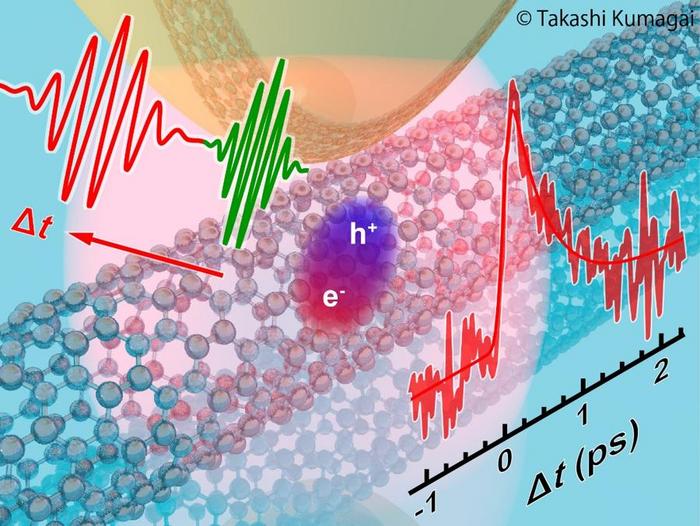In a remarkable advancement in the field of nanophysics, a research team has successfully visualized the ultrafast dynamics of excitons in carbon nanotubes (CNTs) using an innovative ultrafast infrared near-field optical microscope. The study led by Dr. Jun Nishida and Dr. Takashi Kumagai at the Institute for Molecular Science (IMS)/SOKENDAI, along with collaborators from other prestigious institutions, marks a significant leap in understanding the behavior of excitons, which are essentially bound pairs of electrons and holes generated when light interacts with materials.
Excitons play a crucial role in the optoelectronic properties of various materials, especially CNTs, which are renowned for their exceptional optical and electrical attributes. For years, scientists have grappled with the challenge of capturing the transient behavior of excitons due to their confinement to minuscule spatial dimensions and their tendency to exist only for incredibly short durations, often in the femtoseconds to picoseconds range. Conventional measurement techniques have struggled to provide the temporal and spatial resolution needed to directly observe these phenomena.
Dr. Nishida and his team have overcome this challenge by using a cutting-edge approach that utilizes femtosecond laser pulses to probe the intricate dynamics of excitons within CNTs. By generating excitons through visible light excitation, the team employed an ultrafast infrared near-field optical microscope that can focus laser pulses down to the nanoscale. This technique allowed them to visualize both the generation and decay of excitons in real space and time, providing unprecedented insights into their dynamics.
The findings from this study illuminate how the local environment in which excitons exist can significantly influence their behavior. The team observed that subtle variations, such as lattice distortions within individual CNTs and interactions with neighboring CNTs, have a pronounced effect on the generation and relaxation of excitons. These realizations offer a deeper understanding of how local factors shape light-matter interactions at the nanoscale, which is pivotal for the development of advanced optoelectronic devices.
Furthermore, the researchers developed a theoretical framework to interpret their experimental data, focusing on the intricate relationship between excitons and the near-field infrared light. By incorporating aspects like dielectric responses to intra-excitonic transitions, they created simulations that aligned closely with their experimental results. This theoretical foundation not only supports their current findings but also sets the stage for future investigations into excitonic behavior using similar methodologies.
This research is especially significant given the increasing interest in the potential applications of CNTs in next-generation optoelectronic devices and quantum technologies. The ability to observe and manipulate exciton dynamics directly paves the way for designing high-speed nano-optoelectronic devices, harnessing the unique properties of CNTs. With the advancements brought forth by this research, it may soon be possible to engineer systems that can effectively control light-matter interactions at the nanoscale, opening doors to innovations in quantum photonics and beyond.
Dr. Kumagai noted that this achievement signifies a substantial advancement in measurement technology, enabling researchers to directly observe quantum particles like excitons in one-dimensional systems such as CNTs. This capability is expected to accelerate the development of novel applications and enhance our understanding of quantum phenomena.
In addition to the experimental outcomes, the team’s meticulous approach in integrating theoretical modeling with practical observations enriches the robustness of their conclusions. This melding of theory with experimental validation is critical in physics, as it lays the groundwork for future studies that seek to unravel more complex interactions within nanoscale materials.
As researchers worldwide continue to explore the potential of CNTs and similar nanomaterials, this pioneering work serves as a cornerstone for future developments in the field. The insights gleaned from observing excitons in real time have far-reaching implications, potentially revolutionizing the design and functionality of a variety of electronic and photonic devices.
In conclusion, the successful visualization of ultrafast exciton dynamics within carbon nanotubes is not just a technical breakthrough; it represents a paradigm shift in our understanding of light-matter interactions at the nanoscale. The synergetic approach of combining advanced optical instrumentation with solid theoretical modeling heralds a new era in the realms of nanophysics and optoelectronics. As this research paves the way for innovative applications, the scientific community eagerly anticipates the further explorations it will inspire.
Subject of Research: Not applicable
Article Title: Ultrafast infrared nano-imaging of local electron-hole dynamics in CVD-grown single-walled carbon nanotubes
News Publication Date: 18-Jun-2025
Web References: https://doi.org/10.1126/sciadv.adv9584
References: Not applicable
Image Credits: Credit: Takashi Kumagai
Keywords
Nanophysics, carbon nanotubes, excitons, ultrafast infrared microscopy, optoelectronics, quantum technologies, light-matter interaction.




